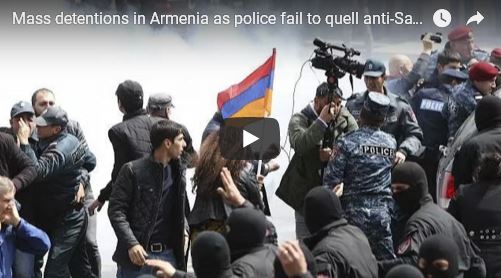
Demonstrators march through the streets of Yerevan, Armenia’s capital, on Monday. Protests forced the resignation of its leader. CreditKaren Minasyan/Agence France-Presse — Getty Images
Eleven days of demonstrations in the streets of Armenia, a tiny post-Soviet country in the south Caucasus region, have shown the world that protests can sometimes have an impact. On Monday, the widely opposed Prime Minister Serzh Sargsyan bowed to the wishes of the thousands of pro-democracy demonstrators and resigned.
“Nikol Pashinyan was right; I was mistaken,” Sargsyan said in a statement about the opposition leader and most prominent face of the protests. “I am leaving the post of prime minister. The Street Movement is against my appointment. I fulfill your request: I wish peace and harmony to our country.”
The atmosphere in the streets was celebratory as Armenians cracked open bottles of wine and waved flags. Some declared that Monday, April 23, 2018, was the beginning of democracy for the formerly communist country whose history has been dominated by its larger neighbors Turkey and Russia.
“This is the beginning of Armenia moving towards democracy. This is what people were protesting for and why they came into the streets. It’s an important milestone,” Maria Karapetyan, a resident of Armenia, told Newsweek.

People celebrate the release of Nikol Pashinyan, the leader of Armenia's mass anti-government protests, in Yerevan on April 23.KAREN MINASYAN/AFP/GETTY IMAGES
Indeed, Sargsyan’s resignation marks an important change for Armenia, where the pro-Russian politician has ruled as president for a decade. His political opponents accused him of changing the country’s laws so he could hold on to power for another 10 years. In late 2015, the country’s government pushed through a controversial constitutional referendum that would downgrade the presidency to a mostly symbolic position and give increased power to the prime minister. Many observers said this change was designed to allow Sargsyan to transition from the presidency to the premiership when his legal term limit was reached.
Sargsyan had always been a controversial figure. At least eight people died during clashes with police when he was elected to office in 2008. He won a second five-year term in 2013 after several political opponents suddenly resigned and one candidate was shot in what many said was an assassination attempt.
Last week, the country’s government did what many of Sargsyan’s opponents had feared and appointed the former president as prime minister. Leaders of Armenia’s ruling Republican Party convened in a ski resort outside the capital to avoid protests as they made their decision.
Opponents immediately called the move an authoritarian takeover, and more demonstrators flooded the streets. Even a large group of Armenia’s military joinedthe anti-government protesters. The protests led to hundreds of arrests and violent clashes between demonstrators and security forces. The crackdown against protesters was condemned by the European Union.
“Youth and students came out to the streets, which was incredible and unprecedented to that scale. Everything was peaceful, except that on the second day police forces shot stun grenades into [the] public, where over 40 people were injured, including protest leader Nikol Pashinyan. [Pashinyan] called for peaceful, decentralized disobedience, and people went out and closed the streets,” Gevorg Babyan, one of the protesters injured in the clashes, told Newsweek.

Sargsyan officially resigned shortly after Pashinyan had been released from prison to much fanfare. The opposition leader said he had been in negotiations with members of the ruling party and would soon make an official statement.
“In many ways, it seems that the real tipping point was the move by some of the Armenian military peacekeeping battalion to side with the demonstrators, undercutting the confidence of the authorities,” Armenian political analyst Richard Giragosian posted on Facebook.
Babyan said he and many of the other demonstrators didn't know what the future would hold, but it is their wish that Sargsyan’s Republican Party of Armenia relinquish its control of the country.
“There is a deep, pyramidal system of corruption in Armenia, and we are opposed to that too. But Serzh Sargsyan was a dictator not only of the people but also of his party, so we hope the pyramid of corruption will collapse too. People are quite strong in their position that the Republican Party must leave,” Babyan told Newsweek. “We will wait few hours for the protest leader to inform us about the road map of the changes. However, we can say that we tackled down one of the worst dictators of our time.”
(newsweek)